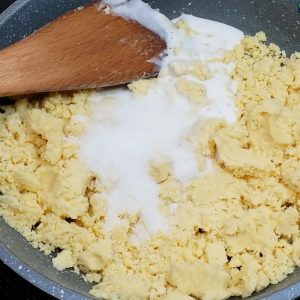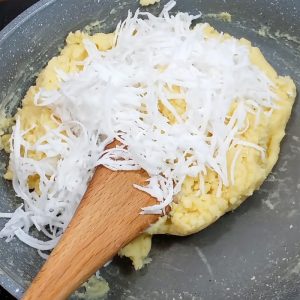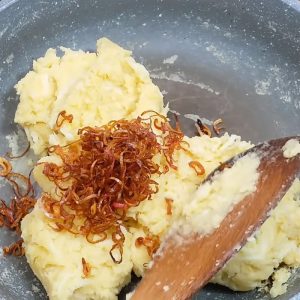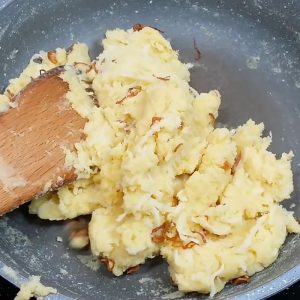Chè Trôi Nước (Sticky Rice Dumplings)
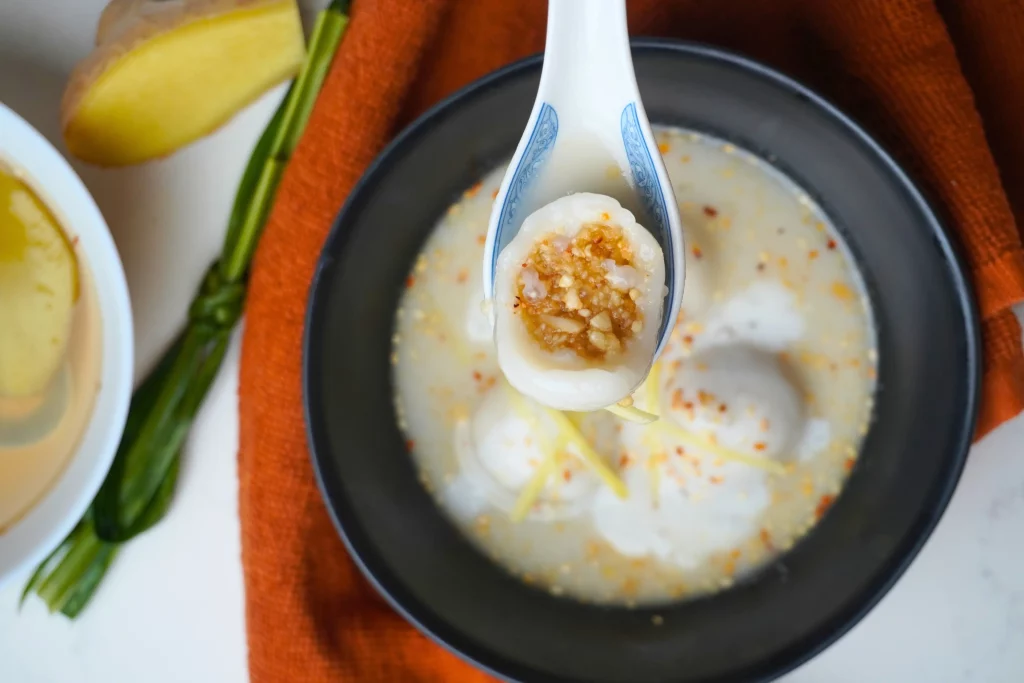
Ingredients
Root & Legume Base
- ½ white sweet potato (steamed and mashed)
- 150g split mung beans (soaked and cooked)
Flour & Texture
- 400g glutinous rice flour
- 3 tsp rice flour
- 1 tbsp tapioca starch
Sweetener & Sauce
- 375g palm sugar (for syrup)
- 2 tbsp sugar (optional, for balance)
- 450ml coconut milk
- 1g vanilla extract (1 tube)
- 70g ginger (julienned)
Topping & Garnish
- 70g shredded coconut
- 2 tbsp fried shallots (optional – may omit for fully vegan version)
- Toasted sesame seeds
- Crushed roasted peanuts
- Pinch of salt
Nutritional Information
For: vegetarians and vegans Calories per serving: ~200 kcal (1 bowl) Key nutrients
1. Healthy Carbs (30–35g)
- Source: Glutinous rice flour + sweet potato + palm sugar
- Benefits: Provides sustained energy, promotes satiety, and helps with digestion thanks to resistant starch in glutinous rice when cooled.
2. Natural Fats (4–6g)
- Source: Coconut milk + shredded coconut + toasted sesame seeds + crushed peanuts
- Benefits: Supports brain and heart health, balances hormones, and aids absorption of fat-soluble nutrients.
3. Plant-Based Protein (4–5g)
- Source: Split mung beans + peanuts
- Benefits: Aids in muscle repair and energy production, helps maintain blood sugar balance
4. Fiber (3–4g)
- Source: Sweet potato + mung beans + coconut
- Benefits: Supports digestive health, regulates blood sugar, and improves cholesterol levels.
5. Antioxidants & Phytochemicals
-
Gingerol (ginger): Anti-inflammatory, good for digestion and circulation.
-
Sesamin (sesame seeds): Supports cholesterol control and has antioxidant effects.
-
Vitamin E (peanuts): Supports skin health and immune function.
6. Essential Minerals
- Iron (mung beans, sesame, peanuts): Supports oxygen transport in the body.
- Potassium (sweet potato): Balances fluids and supports nerve/muscle function.
- Magnesium (peanuts, coconut): Helps with muscle and nerve function, energy production.
1. Prepare Mung Beans & Sweet Potato
-
Rinse mung beans, soak in salted warm water (1 tsp salt + 1L water) for 1 hour.
-
Peel and halve sweet potato. Steam both for 30 minutes until tender, then mash separately.
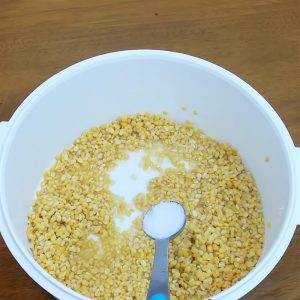
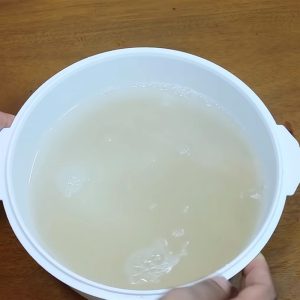
2. Make the Dough
- First, peel half of a white sweet potato and cut it in half, so it will cook faster when steamed. After soaking the beans, drain the water and put them in a steamer with the white sweet potato for 30 minutes.After the beans and potatoes are soft, separate them into 2 bowls and use a spoon to mash both.

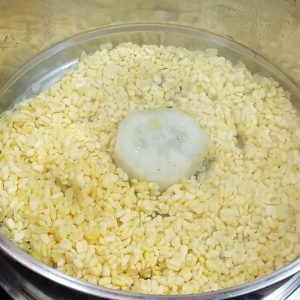
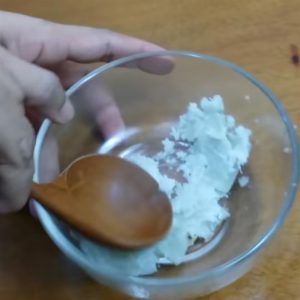
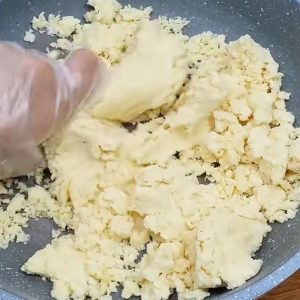
3. Cook the Filling
-
Add mashed white sweet potato to 400g glutinous rice flour, add 360 ml warm water and 1/4 teaspoon salt and mix well.
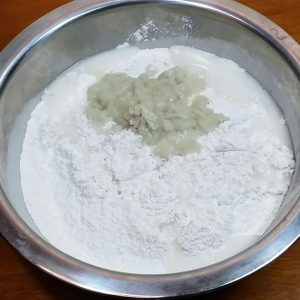

4. Knead and let the dough rise
Knead the dough by hand for about 20 minutes until the dough is soft and slightly buoyant. If you try to pull it out, it will be elastic, but will be crumbly and easily broken.
Then, cover the dough with plastic wrap and let it rest for 3-4 hours.
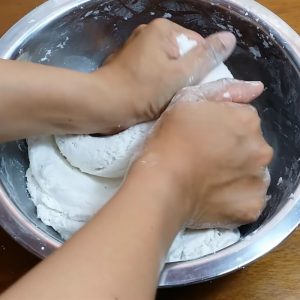
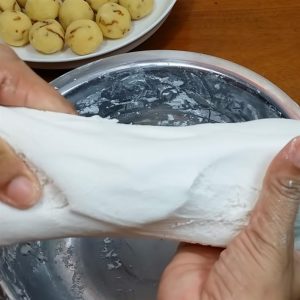
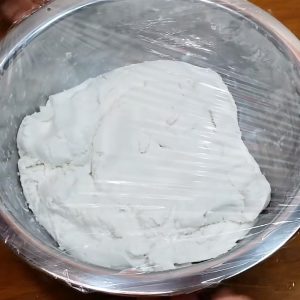
5. Cooking the Mung Bean and Coconut Filling
– Prepare the Coconut Mixture:
- In a pot, combine 320ml coconut milk, 125ml water, ⅓ tsp salt, 1 tbsp tapioca starch, and 3 tsp rice flour. Stir well until fully dissolved.
- Cook over low heat, stirring constantly until thickened. Remove from heat, add 1g (1 tube) vanilla extract, and mix well.
– Cook the Mung Bean Filling:
- In a pan, mix the mashed mung beans with 80ml coconut milk, ½ tsp salt, and 2 tbsp sugar.
- Cook over low heat, stirring continuously until the mixture thickens and slightly dries out.
– Finalize the Filling:
- Add 70g shredded coconut, mixing until the filling becomes smooth, sticky, and cohesive (no crumbly bits left).
- Finish by stirring in 2 tbsp fried shallots for a savory aroma.
6. Green bean filling
Shape the filling into balls, each ball is about 20gr. Next, you also shape the dough into balls about 30gr.
Use your thumb to press down on the dough to form a circle just enough, then put the filling in, then roll the dough so that the dough wraps tightly and covers the green bean filling.
You can roll the remaining dough into small balls like pearls!
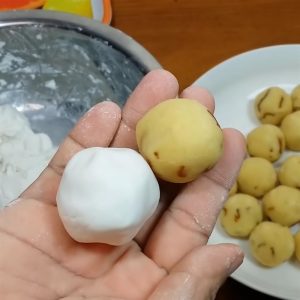
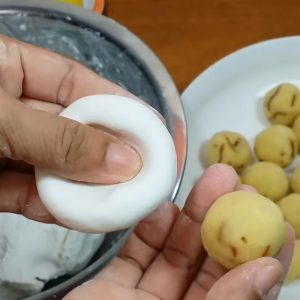
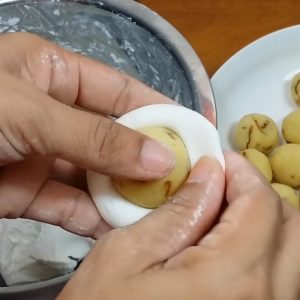
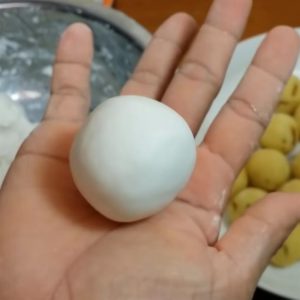
7. Cook sweet soup with Ginger Palm Sugar Syrup
Place a pot on the stove with 1 liter of water. Add 375g of palm sugar and 1 teaspoon of salt, stirring until fully dissolved. Taste and adjust the sweetness to your liking.
Add 70g of julienned ginger and bring to a boil. Then gently drop in the molded dessert balls. Cook over medium heat for about 15 minutes, or until the balls float to the surface, with their outer layer puffed up and slightly translucent. Turn off the heat.
Transfer the dessert balls to a bowl, drizzle with a bit of coconut milk, and top with roasted sesame seeds and peanuts. Now it’s ready to enjoy!
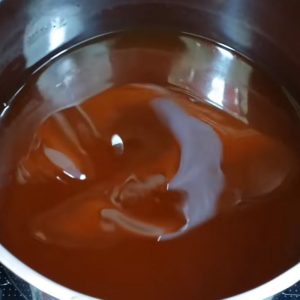
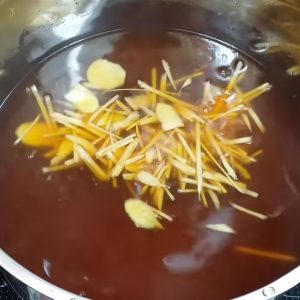
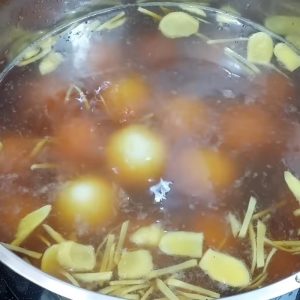
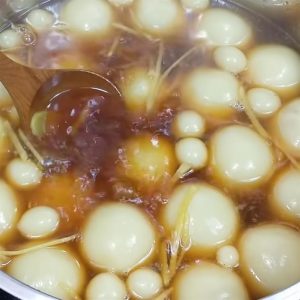
Finished Dish
This sweet glutinous rice ball dessert is a true delight for the senses, featuring perfectly round, plump balls that are visually pleasing and infused with the warm, fragrant aroma of ginger. The outer layer is soft and chewy, while the mung bean filling inside is rich, creamy, and delicately sweet—an irresistible combination.
With this method, your rice balls won’t turn hard over time, so you can store them longer while keeping their ideal soft and chewy texture. Give it a try and treat your family to this comforting homemade dessert!
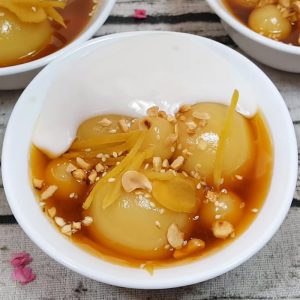
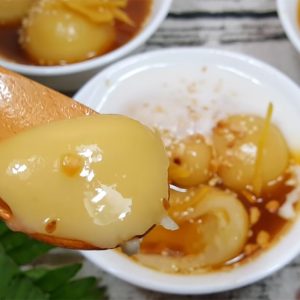
Sticky rice dumplings in ginger syrup, known in Vietnamese as chè trôi nước, are not merely a dessert to enjoy — they are a delicate slice of Vietnam’s cultural soul, lovingly wrapped in each tender, round dumpling. For generations, this dish has graced ancestral altars during the Cold Food Festival (the third day of the third lunar month) and family memorials, where the sight of pale, plump dumplings gently floating in warm ginger syrup evokes the cycles of life, reunion, and wholeness.
In ancient belief, the round shape symbolized completeness — just like how the dumplings rise to the surface when they’re perfectly cooked. In the cool chew of glutinous rice, the nutty sweetness of mung bean filling, the spicy warmth of ginger, and the creamy touch of coconut milk lies a rustic yet profound harmony — much like the spirit of the Vietnamese people.
But chè trôi nước is more than taste and memory — it is also a powerful literary symbol. One of Vietnam’s most iconic female poets, Hồ Xuân Hương, used the image of these floating dumplings to reflect the fate, resilience, and quiet strength of women in her poem “Bánh trôi nước”:
“Bánh trôi nước” – Hồ Xuân Hương
Thân em vừa trắng lại vừa tròn,
Bảy nổi ba chìm với nước non,
Rắn nát mặc dầu tay kẻ nặn,
Mà em vẫn giữ tấm lòng son.
“Floating Rice Dumplings” – translated
My body is both white and round,
Tossed up and down in water’s flow.
Though hands may crush or mold my form,
My heart stays true and full of glow.
Through this verse, the dessert transforms into a symbol of womanhood — beautiful, fragile, yet unshakably steadfast. In every bowl of chè trôi nước, we are reminded of how food, poetry, and identity intertwine in the most unexpected, tender ways.
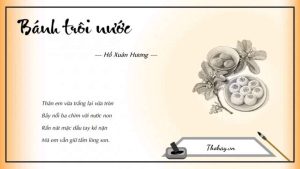
(“Bánh trôi nước” – Hồ Xuân Hương)
